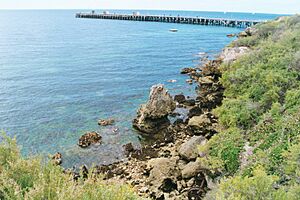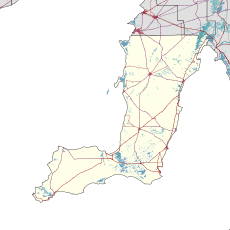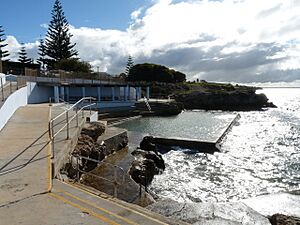Edithburgh facts for kids
Quick facts for kids EdithburghSouth Australia |
|||||||||||||||
|---|---|---|---|---|---|---|---|---|---|---|---|---|---|---|---|

Edith Street
|
|||||||||||||||
| Established | 1869 | ||||||||||||||
| Postcode(s) | 5583 | ||||||||||||||
| Location | |||||||||||||||
| LGA(s) | Yorke Peninsula Council | ||||||||||||||
| Region | Yorke and Mid North | ||||||||||||||
| County | Fergusson | ||||||||||||||
| State electorate(s) | Narungga | ||||||||||||||
| Federal Division(s) | Grey | ||||||||||||||
|
|||||||||||||||
|
|||||||||||||||
| Footnotes | Adjoining localities | ||||||||||||||
Edithburgh is a small town located on the south-east side of the Yorke Peninsula in South Australia. It sits right on the coast of Salt Creek Bay. Edithburgh is about 50 kilometres (31 miles) west of Adelaide if you travel straight across Gulf St Vincent. However, by road, it's about 226 kilometres (140 miles) away.
The town is part of the Yorke Peninsula Council. It also falls within the state government's Electoral district of Narungga and the federal government's Division of Grey.
Contents
History of Edithburgh
Early Days and Naming
The land where Edithburgh now stands was originally known as Pararmarati by the Indigenous Narungga people. This name comes from their language, Narangga.
The first European settlers arrived in the 1840s. They were mostly sheep farmers. In 1869, a place was chosen for a jetty to help the growing farming community. A town was then planned next to it. The town's design was similar to Adelaide, but smaller, even including parklands.
Edithburgh was named by Governor Sir James Fergusson. He named it after his wife, Edith, who passed away in 1871. The new jetty officially opened in 1873.
The 2019 Bushfires
In November 2019, some bushfires affected the Yorke Peninsula. On November 21, a fire threatened Edithburgh, Coobowie, and Wool Bay. Strong winds pushed the fire towards the coast. Many people from the area found safety overnight in the Edithburgh Town Hall. Thankfully, no one was hurt. It was later found that the fire started because of a problem with the power network.
Industries and Economy
Past and Present Industries
Edithburgh first grew as a port. It helped the early farmers by shipping their goods. In the 1870s, grain farming became very important for the local economy, and it still is today.
Around the year 1900, new industries started up. These included mining for gypsum and refining salt. There are many salt lakes in the area. Salt was collected from these lakes and sent to places as far away as Russia. The jetty became a very busy place for sending out these products and bringing in supplies.
Today, the jetty is mostly used for fishing. It's also a very popular spot for scuba diving. There's still a small fleet of boats that fish for seafood like prawns. The town is also near the Wattle Point Wind Farm. This farm has 55 wind turbines and started working in 2005.
Tourism and Attractions
Edithburgh is known for its beautiful coastal views. It has tall rocky cliffs and sandy beaches. You can even see Troubridge Island from the shore. Because of its beauty, tourism is now a growing industry here.
It's a popular place for holidays. You can find different types of places to stay, including a caravan park. The Troubridge Hotel and the Edithburgh Hotel are across from each other. Both are named after Governor Fergusson's daughters, Blanche and Edith.
If you prefer not to swim in the open sea, Edithburgh has a special seawater swimming pool. It's built right on the shoreline. The pool's water is naturally refilled with each high tide, making it a safe and fun place to swim.
Diving and Snorkelling

The Edithburgh jetty is considered one of the best places for scuba diving in South Australia. It's easy to get into the water because there are steps on both sides of the jetty.
The jetty stretches 170 metres (558 feet) out into Gulf St Vincent. It is supported by groups of four poles, called pylons. Divers and snorkellers can get close to colourful groups of corals and sponges growing on these pylons. The pylons also provide homes for many fish, crustaceans, nudibranchs, and other small sea creatures.
You can even see some of South Australia's most famous marine animals here. These include the amazing Leafy sea dragon and the unique Striped pyjama squid.
The deepest you can dive here is about 10–12 metres (33–39 feet). This makes it a great spot for divers of all skill levels.
Jetty Maintenance and Marine Life
In 2013, some maintenance work was done on the Edithburgh jetty. About 50 of the jetty's pylons were removed. This caused a loss of homes for marine life. Many divers and people who care about the ocean were upset by this.
The pylons had been identified as a safety risk a few years earlier. However, it seems that the impact on the marine environment or on Edithburgh's popularity as a dive spot was not fully considered.
Divers from the M.E. Dive Club saw the work happening. They organized a group to check the damage. The pylon removal was not announced publicly, and the diving community was not asked for their opinion. Groups like the Scuba Divers Federation of South Australia and the Marine Life Society of South Australia wrote letters to the government about the issue.
Images for kids
Notable People
- Jamie Tape - An Australian Rules Football (AFL) player.













